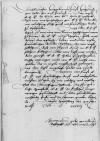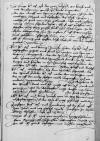Letter #5200
Ioannes DANTISCUS to Albrecht I von Hohenzollern-AnsbachHeilsberg (Lidzbark Warmiński), 1538-09-15
| received Königsberg (Królewiec), 1538-09-16 Manuscript sources:
Auxiliary sources:
Prints:
| ||||||||
Text & apparatus & commentary Plain text Text & commentary Text & apparatus
 GStA, PK, HBA, C 1, No 519, f. 2r
GStA, PK, HBA, C 1, No 519, f. 2r
Dem durchlauchtenn, hochgebornen furstenn(n) und herrn, herrn
 GStA, PK, HBA, C 1, No 519, f. 1r
GStA, PK, HBA, C 1, No 519, f. 1r
Durchlauchter, hochgeborner(r) furst, hochgunstiger, lÿber her und freundt. /
Das unss E(wer) F(urstliche) D(urchlauch)t dÿ cf.
Wÿ aber E(wer) F(urstliche) D(urchlauch)t begert, / so uns was von newen tzeÿthungen(n) weren zu komen(n), / dÿ E(wer) D(urchlauch)t mit zu theylen, / haldt wirs dovor(r), / das vÿleicht andere und zuvor unser freuntlicher bruder
Worinne wir sunst E(wer) F(urstliche) D(urchlauch)t vÿl freuntlicher dinst und wolgefallen wusten zu thun, / seÿ wir erbothig und wÿllig, / Gott den almechtigen(n) bÿttendt, / das sein gotliche maiestatt E(wer) F(urstliche) D(urchlauch)t in frÿscher(r), langweriger gesuntheÿtt und aller gluckselichen wolfarth friste / und in seÿnnen gnaden behalde. /
Datum(m)
Dÿ
Umb
Der friede zwischenn(n)
Weÿs E(wer) F(urstliche) D(urchlauch)t was von unserm(m) hochgelybtenn(n) hern marggraff


